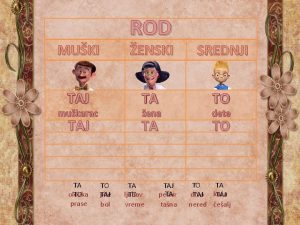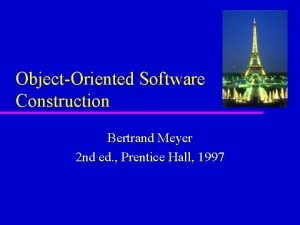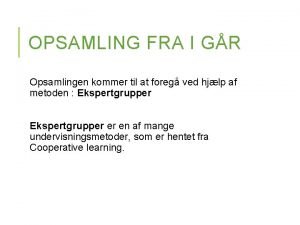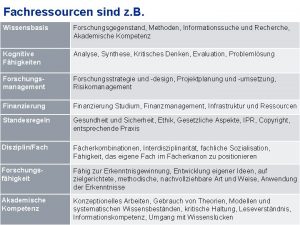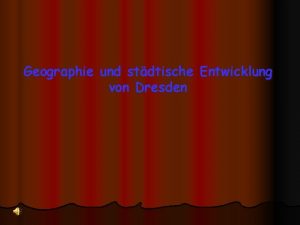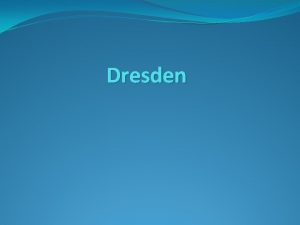ROD Activities at Dresden Andreas Glatte Andreas Meyer












- Slides: 12

ROD Activities at Dresden Andreas Glatte, Andreas Meyer, Andy Kielburg-Jeka, Arno Straessner LAr Electronics Upgrade Meeting – LAr Week September 2009 1

Outline • ROD trigger L 1 and L 2/EF buffers • Concept for ROD and ROB/ROS • Test Setup in Dresden • Outlook 2

ROD Trigger Buffers and Data Rates • Expected data rates and buffer sizes for one ROD: • at input: ~100 Gbps/FEB x 14 • reduction by L 1 trigger sums: ~ factor 10 (? ) → ~ 140 Gbps to L 1 Calo (? ) • L 1 buffer size (latency 5 μs): ~ 7. 2 Mbit (? ) • assumption: 5 -sample energy+time is calculated each 25 ns • per cell: 16 bit energy/gain/parity + 20%*16 bit time/quality ~ 20 bit → *128 channels *14 FEB *40 MHz * 5 μs = 7. 2 Mbit) • L 1 accept rate: ~200 k. Hz • L 2/EF output rate = ROB input rate: 8. 6 Gbps → over ATCA backplane • derived from the following expectation: 14 FEB * 128 channel * 16 bit * 1. 2 time/quality * 1. 25 (10/8 enc. ) * 200 k. Hz = 8. 6 Gbps • maximum rate could however be: (based on today’s ROB max. input rate) (1. 28 Gbps / 2 FEB) * 14 FEB * 200 k. Hz/100 k. Hz = 18 Gpbs • L 2 latency: ~ 40 ms • ROB buffer size: 4. 1 Gbit (for 12 RODs = 1 crate) • 8. 6 Gbps * 12 * 40 ms • ROB output rate (data requested by L 2/EF/DAQ): ~ 4 Gbps • 0. 3 Gbps / (12 links * 2 FEB) * 14 FEB * 12 ROD * 2 (occupancy) 3

different options Communication between ROD and ROB/ROS 4

ROB/ROS 5

Test Setup 6

ATCA 10 Gb. E Test Setup • test environment in Dresden: • Radi. Sys Promentum ATCA Sys-6010 • equipped with ROD Board and 10 GE Switch incl. 10 GE XFP transceiver • Dual Xeon Server equipped with one 10 GE dualport Myricom NIC incl. optical SFP+ transceiver • current achievements: • external loopback between both ports of NIC (“Send -to-Self” Linux kernel patch needed) • bandwidth w/ and w/o ATCA Switch: ~9. 90 GBit/s with MTU 9000 (TCP/UDP Stream) • next steps: • implement and test Remote DMA: • DMA access via Ethernet • minimize CPU usage during memory access • Server → NIC → (switch) → NIC → Server • test performance limits of RDMA/Server-CPU: • data transfer with 4 Myricom cards planned ROD Switch Server optical wiring (orange) and switch management (green, gray) 7

10 Gb. E Data Transfer With FPGA • try 10 Gb. E data transfer with FPGA → possible format to send data to ROB/L 2/DAQ interface • possible architecture in ATCA crate: BNL ROD ATCA Blade FPGA (Xilinx Virtex 5 - XC 5 VFX 70 T) 10 Gbit Eth. 10 -Gbit Eth. User Logi c 10 -Gigabit Ethernet MAC Core 10 -Gbit Eth. Host PC over XGMII XAUI IP-Core Switch Blade over XAUI ATCA -Back plane 10 Gbit Eth. over Fiber GTXTrans ceive r 10 Gigabit Ethernet Switch XAUI 8

10 Gb. E Data Transfer With FPGA • R&D goal: • use standardized protocol to be compatible with commercial components • use commercial ROB based on ATCA blade with • at least eight 10 Gb. E links to fabric does not exist now, • fast CPU but certainly in future • 2 -4 10 Gb. E ports as interface to L 2/EF/DAQ today: CPU blades with two 10 Gb. E on fabric • commercial 10 Gb. E MAC IP core from Xilinx very expensive • free XAUI IP core exists from Xilinx • want to try 10 Gb. E MAC from opencores. org • currently working on 1 Gb. E • some last problems to be solved • many people are active to use 10 Gb. E technology • expect to get increased performance in future (next couple of years): • 40 -100 Gb. E 9

Control Interface For ATCA Crate • before we received server PC and ROD prototype: • learn about ATCA switch setup and crate control information • PVSS used for control interface → reading of status info via Radisys HPI library Linux Host PVSS file system C based Appl. HPI client library 100 MBit Ethernet HPI ATCA Crate

Simulation of Electronics and Signal Processing • currently also thinking about digital fiter, L 1 buffer and L 1 Calo interface: • started to simulate electronic signals with pile-up • goal: optimize readout timing / digitial filter / trigger tower size • this is needed to get a new/optimal and possibly flexible mapping of cells to trigger sums • will be important to estimate ROD-to-ROD and ROD-to-L 1 Calo rates and architecture • first step: simple ROOT software for fast tests • will be extended with more realistic pulse shapes and pile-up spectra “ideal” pile-up and 20 Ge. V deposits single pulse and pile-up @ 1035 cm-2 s-1 digitally filtered signal

Summary and Outlook • we are learning to use ATCA and 10 Gb. E • performance with server PC and ATCA switch reaches 9. 9 Gbps as expected • next big projects: • Remote DMA • 10 Gb. E in FPGA • continue electronics simulation → ROD/L 1 Calo interface 12
 Andreas glatte
Andreas glatte Muski zenski srednji rod
Muski zenski srednji rod Outdoor sports name
Outdoor sports name Primary and support activities
Primary and support activities Examples of primary activities
Examples of primary activities Operating activities vs investing activities
Operating activities vs investing activities Modular decomposability
Modular decomposability Meyerbriggs
Meyerbriggs Acct20100
Acct20100 Shock wave definition
Shock wave definition Illeris læringstrekant
Illeris læringstrekant Behn meyer specialty chemicals llp
Behn meyer specialty chemicals llp Marco meyer waarden
Marco meyer waarden

